Branchial Cleft Cyst | Symptoms & Causes
What are the symptoms of a branchial cleft cyst or sinus tract?
The specific signs and symptoms of a branchial cyst or sinus tract depend upon the branchial arch or cleft of origin. As a result there are several types of branchial cleft cysts and sinus tracts.
First branchial cleft cysts and sinus tracts
First branchial cleft cysts occur just in front of or below the ear at the angle of the jawline. The external sinus tract opening can be above the jawline (type I) or below the jawline in the upper neck above the level of the hyoid bone (type II). If there is an internal opening, it will be in the ear canal.
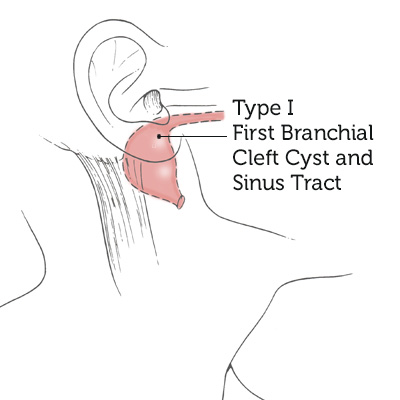
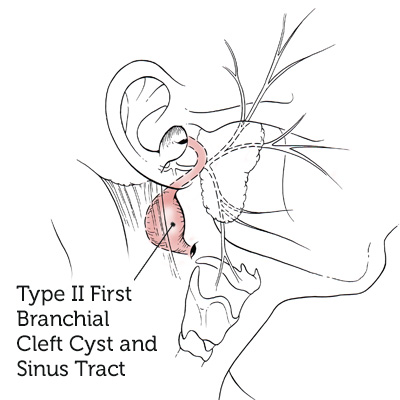
Second branchial cleft cysts and sinus tracts
Second branchial cleft cysts occur in the upper lateral neck. The external sinus tract opening will be in the upper lateral neck between the hyoid and thyroid cartilages, just anterior to a large neck muscle known as the sternocleidomastoid (SCM) muscle. If there is an internal opening, it will be in the back of the throat in the tonsil region.
Third and fourth branchial cleft cysts and sinus tracts
Third and fourth branchial cleft cysts occur in the lower lateral neck. The external sinus tract opening will be in the lower lateral neck below the thyroid and cricoid cartilages, just anterior to the SCM muscle. If there is an internal opening, it will be deep within the throat in a region called the pyriform sinus.
Sometimes third and fourth branchial anomalies can have only an internal opening with no external opening. In such circumstances, they can present as recurrent neck infections in the region of the thyroid gland.
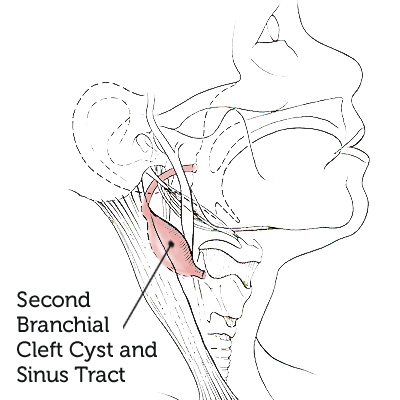
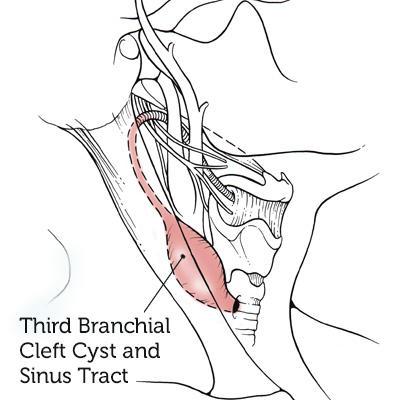
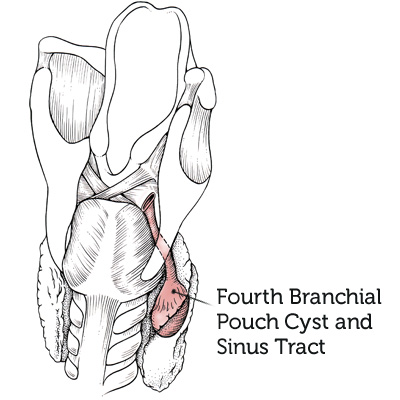
What causes branchial cleft cysts or sinus tracts?
Branchial cleft cysts and sinus tracts are congenital anomalies, meaning they result from an unexpected change in the womb before birth. Although most commonly unilateral (occurring on one side of the neck), they can be bilateral (both sides of the neck). When bilateral, they can be associated with other congenital anomalies. For example, if your child has bilateral branchial cleft sinus tracts in the neck and in front of the ears (pre-auricular), they may have branchio-oto-renal (BOR) syndrome, which can be associated with hearing loss or kidney abnormalities.
Branchial Cleft Cyst | Diagnosis & Treatments
How are branchial cleft cysts and sinus tracts diagnosed?
External branchial cleft sinus tracts are readily apparent on physical examination. Most are diagnosed in infancy. Special imaging studies using dye placed through the external opening are sometimes used to determine the depth of the tract.
Sinus tracts with only an internal opening are much more challenging to identify. A special examination under anesthesia called endoscopy is often necessary to confirm the diagnosis.
Branchial cleft cysts are often discovered during a physical examination in a child who is showing no other symptoms. Either the family or the physician detects a mass in the upper or lower lateral neck.
As mentioned previously, an infected branchial cleft cyst may present as a suddenly enlarging tender neck mass. Recurrent neck infections (abscesses) should raise concern of a branchial cleft cyst with an internal communication to the throat.
Since a variety of different masses can occur in the neck, an imaging study often needs to be performed. Generally the initial study is a cervical ultrasound, although a computed tomography (CT) scan or magnetic resonance imaging (MRI) scan may be necessary for further anatomical definition of the cyst in preparation for future surgical excision.
There are other congenital cystic neck masses that can closely resemble a branchial cleft cyst. The most common is a dermoid cyst. Sometimes a dermoid cyst cannot be distinguished from a branchial cleft cyst based on the combination of the physical examination and imaging studies, and the answer is not known until the mass is removed and examined by a pathologist.
How are branchial cleft cysts and sinus tracts treated?
The treatment for branchial cleft cysts and sinus tracts is surgical removal.
There is no known medical therapy with the exception that infected branchial cleft cysts and sinus tracts do require initial antibiotic treatment. The infection should be resolved before surgery is performed.
Branchial cleft sinus tracts often have drainage of mucous-like material. This material is produced by glands that line the sinus tract. Although not truly a sign of infection, excessive drainage can be bothersome, prompting surgical intervention.
Treatment requires complete surgical removal of the cyst and possibly the sinus tract. The exact procedure performed depends upon the anatomical location and type of the branchial cleft abnormality. Some operations can be very straightforward and others quite complicated. The operative removal of type II first branchial cleft abnormalities is particularly challenging, requiring partial removal of the parotid gland for identification and preservation of the facial nerve.
Complications include those common to any open neck operation such as hematoma, seroma, postoperative infection, and a neck scar. In specific cases, nerve weakness or paralysis is a risk as well.
How we care for branchial cleft cysts and sinus tracts
The treatment of branchial cleft cysts and sinus tracts requires an operation performed by a surgeon trained in head and neck surgery. The surgeons in the Boston Children’s Hospital Department of Otolaryngology and in the Department of Surgery have this depth of expertise. They perform this surgery in a family centered environment with pediatric anesthesiologists, nurses, and assistive personnel all extensively trained and experienced in pediatric surgical care.

